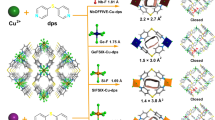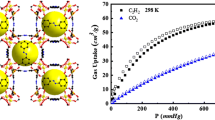Abstract
Cationic azole-based metal-organic frameworks (MOFs) with remarkable stability and unique pore environment have aroused great research interests. Meanwhile, flexible MOFs which can undergo pore-structure changes upon exposure to external stimuli are ideal materials for gas separation. However, introducing flexibility into the framework of cationic azole-based MOFs is rarely reported. Herein, we synthesized two stable isomorphic cationic MOFs (M-btz-as, M = Co, Ni) based on a linear azole ligand. After activated at high temperature under vacuum, M-btz-ht (M = Co, Ni) were obtained and both MOFs exhibited flexible features in which Co-btz is more flexible than Ni-btz. Different solvent-mediated activation methods were employed to explore their effects on structural flexibility and produced MOFs with different phases. Continuous phase transformation of Co-btz-e was verified by powder X-ray diffraction. In addition, these MOF phases possessed different gas separation abilities affected by their flexible frameworks, and Co-btz-ht exhibited the highest CO2/CH4 separation ability.

Similar content being viewed by others
References
Ding, M. L.; Flaig, R. W.; Jiang, H. L.; Yaghi, O. M. Carbon capture and conversion using metal-organic frameworks and MOF-based materials. Chem. Soc. Rev. 2019, 48, 2783–2828.
Chen, Y. W.; Zhang, X.; Chen, H. Y.; Drout, R. J.; Chen, Z. J.; Mian, M. R.; Maldonado, R. R.; Ma, K. K.; Wang, X. K.; Xia, Q. B. et al. Tuning the atrazine binding sites in an indium-based flexible metal-organic framework. ACS Appl. Mater. Interfaces 2020, 12, 44762–44768.
Sun, T. T.; Xu, L. B.; Wang, D. S.; Li, Y. D. Metal organic frameworks derived single atom catalysts for electrocatalytic energy conversion. Nano Res. 2019, 12, 2067–2080.
Si, Y. N.; He, X.; Jiang, J.; Duan, Z. M.; Wang, W. J.; Yuan, D. Q. Highly effective H2/D2 separation in a stable Cu-based metal-organic framework. Nano Res. 2021, 14, 518–525.
Hou, J. W.; Sutrisna, P. D.; Wang, T. S.; Gao, S.; Li, Q.; Zhou, C.; Sun, S. J.; Yang, H. C.; Wei, F. X.; Ruggiero, M. T. et al. Unraveling the interfacial structure-performance correlation of flexible metal-organic framework membranes on polymeric substrates. ACS Appl. Mater. Interfaces 2019, 11, 5570–5577.
Qin, J. S.; Yuan, S.; Alsalme, A.; Zhou, H. C. Flexible zirconium MOF as the crystalline sponge for coordinative alignment of dicarboxylates. ACS Appl. Mater. Interfaces 2017, 9, 33408–33412.
Burtch, N. C.; Jasuja, H.; Walton, K. S. Water stability and adsorption in metal-organic frameworks. Chem. Rev. 2014, 114, 10575–10612.
Yao, J. F.; Wang, H. T. Zeolitic imidazolate framework composite membranes and thin films: Synthesis and applications. Chem. Soc. Rev. 2014, 43, 4470–4493.
Huang, X. C.; Zhang, J. P.; Chen, X. M. [Zn(bim)2]·(H2O)1.67: A metal-organic open-framework with sodalite topology. Chin. Sci. Bull. 2003, 48, 1531–1534.
Park, K. S.; Ni, Z.; Côté, P.; Choi, J. Y.; Huang, R. D.; Uribe-Romo, F. J.; Chae, H. K.; O’Keeffe, M.; Yaghi, O. M. Exceptional chemical and thermal stability of zeolitic imidazolate frameworks. Proc Natl Acad Sci USA 2006, 103, 10186–10191.
Shi, Z. L.; Tao, Y.; Wu, J. S.; Zhang, C. Z.; He, H. L.; Long, L. L.; Lee, Y.; Li, T.; Zhang, Y. B. Robust metal-triazolate frameworks for CO2 capture from flue gas. J. Am. Chem. Soc. 2020, 142, 2750–2754.
Desai, A. V.; Manna, B.; Karmakar, A.; Sahu, A.; Ghosh, S. K. A water-stable cationic metal-organic framework as a dual adsorbent of oxoanion pollutants. Angew. Chem. 2016, 128, 7942–7946.
Karmakar, A.; Desai, A. V.; Ghosh, S. K. Ionic metal-organic frameworks (iMOFs): Design principles and applications. Coord. Chem. Rev. 2016, 307, 313–341.
Wang, L. H.; Ye, Y. X.; Li, Z. Y.; Lin, Q. J.; Ouyang, J.; Liu, L. Z.; Zhang, Z. J.; Xiang, S. C. Highly selective adsorption of C2/C1 mixtures and solvent-dependent thermochromic properties in metalorganic frameworks containing infinite copper-halogen chains. Cryst. Growth Des. 2017, 17, 2081–2089.
Li, X. X.; Gong, Y. Q.; Zhao, H. X.; Wang, R. H. Anion-directed assemblies of cationic metal-organic frameworks based on 4,4′-bis(1,2,4-triazole): Syntheses, structures, luminescent and anion exchange properties. Inorg. Chem. 2014, 53, 12127–12134.
Huang, G.; Yang, L.; Yin, Q.; Fang, Z. B.; Hu, X. J.; Zhang, A. A.; Jiang, J.; Liu, T. F.; Cao, R. A comparison of two isoreticular metalorganic frameworks with cationic and neutral skeletons: Stability, mechanism, and catalytic activity. Angew. Chem., Int. Ed. 2020, 59, 4385–4390.
Sharma, S.; Desai, A. V.; Joarder, B.; Ghosh, S. K. A water-stable ionic MOF for the selective capture of toxic oxoanions of SeVI and AsV and crystallographic insight into the ion-exchange mechanism. Angew. Chem., Int. Ed. 2020, 59, 7788–7792.
Li, C. P.; Ai, J. Y.; Zhou, H.; Chen, Q.; Yang, Y. J.; He, H. M.; Du, M. Ultra-highly selective trapping of perrhenate/pertechnetate by a flexible cationic coordination framework. Chem. Commun. 2019, 55, 1841–1844.
Sumida, K.; Horike, N.; Furukawa, S. Dynamic properties of a flexible metal-organic framework exhibiting a unique “picture frame”-like crystal morphology. Nano Res. 2021, 14, 432–437.
Schneemann, A.; Bon, V.; Schwedler, I.; Senkovska, I.; Kaskel, S.; Fischer, R. A. Flexible metal-organic frameworks. Chem. Soc. Rev. 2014, 43, 6062–6096.
Zhang, Y. Y.; Zhang, X.; Chen, Z. J.; Otake, K. I.; Peterson, G. W.; Chen, Y. W.; Wang, X. J.; Redfern, L. R.; Goswami, S.; Li, P. et al. A flexible interpenetrated zirconium-based metal-organic framework with high affinity toward ammonia. ChemSusChem 2020, 13, 1710–1714.
Ehrling, S.; Senkovska, I.; Bon, V.; Evans, J. D.; Petkov, P.; Krupskaya, Y.; Kataev, V.; Wulf, T.; Krylov, A.; Vtyurin, A. et al. Crystal size versus paddle wheel deformability: Selective gated adsorption transitions of the switchable metal-organic frameworks DUT-8(Co) and DUT-8(Ni). J. Mater. Chem. A 2019, 7, 21459–21475.
McGuirk, C. M.; Runčevski, T.; Oktawiec, J.; Turkiewicz, A.; Taylor, M. K.; Long, J. R. Influence of metal substitution on the pressure-induced phase change in flexible zeolitic imidazolate frameworks. J. Am. Chem. Soc. 2018, 140, 15924–15933.
Chanut, N.; Ghoufi, A.; Coulet, M. V.; Bourrelly, S.; Kuchta, B.; Maurin, G.; Llewellyn, P. L. Tailoring the separation properties of flexible metal-organic frameworks using mechanical pressure. Nat. Commun. 2020, 11, 1216.
Bloch, W. M.; Babarao, R.; Hill, M. R.; Doonan, C. J.; Sumby, C. J. Post-synthetic structural processing in a metal-organic framework material as a mechanism for exceptional CO2/N2 selectivity. J. Am. Chem. Soc. 2013, 135, 10441–10448.
Zhang, P. D.; Wu, X. Q.; He, T.; Xie, L. H.; Chen, Q.; Li, J. R. Selective adsorption and separation of C2 hydrocarbons in a “flexible-robust” metal-organic framework based on a guest-dependent gate-opening effect. Chem. Commun. 2020, 56, 5520–5523.
Zhang, Y. Y.; Zhang, X.; Lyu, J.; Otake, K. I.; Wang, X. J.; Redfern, L. R.; Malliakas, C. D.; Li, Z. Y.; Islamoglu, T.; Wang, B. et al. A flexible metal-organic framework with 4-Connected Zr6 nodes. J. Am. Chem. Soc. 2018, 140, 11179–11183.
Shi, Y. X.; Li, W. X.; Zhang, W. H.; Lang, J. P. Guest-induced switchable breathing behavior in a flexible metal-organic framework with pronounced negative gas pressure. Inorg. Chem. 2018, 57, 8627–8633.
Carrington, E. J.; McAnally, C. A.; Fletcher, A. J.; Thompson, S. P.; Warren, M.; Brammer, L. Solvent-switchable continuous-breathing behaviour in a diamondoid metal-organic framework and its influence on CO2 versus CH4 selectivity. Nat. Chem. 2017, 9, 882–889.
Huang, Y. K.; Zhang, J.; Yue, D.; Cui, Y. J.; Yang, Y.; Li, B.; Qian, G. D. Solvent-triggered reversible phase changes in two manganese-based metal-organic frameworks and associated sensing events. Chem.—Eur. J. 2018, 24, 13231–13237.
Choi, H. J.; Dincă, M.; Long, J. R. Broadly hysteretic H2 adsorption in the microporous metal-organic framework Co(1,4-benzenedipyrazolate). J. Am. Chem. Soc. 2008, 130, 7848–7850.
Yan, Y.; O’Connor, A. E.; Kanthasamy, G.; Atkinson, G.; Allan, D. R.; Blake, A. J.; Schröder, M. Unusual and tunable negative linear compressibility in the metal-organic framework MFM-133(M) (M = Zr, Hf). J. Am. Chem. Soc. 2018, 140, 3952–3958.
Taylor, M. K.; Runčevski, T.; Oktawiec, J.; Bachman, J. E.; Siegelman, R. L.; Jiang, H.; Mason, J. A.; Tarver, J. D.; Long, J. R. Near-perfect CO2/CH4 selectivity achieved through reversible guest templating in the flexible metal-organic framework Co(bdp). J. Am. Chem. Soc. 2018, 140, 10324–10331.
Gao, Q.; Xu, J.; Cao, D. P.; Chang, Z.; Bu, X. H. A rigid nested metal-organic framework featuring a thermoresponsive gating effect dominated by counterions. Angew. Chem., Int. Ed. 2016, 55, 15027–15030.
Millange, F.; Guillou, N.; Walton, R. I.; Grenèche, J. M.; Margiolaki, I.; Férey, G. Effect of the nature of the metal on the breathing steps in MOFs with dynamic frameworks. Chem. Commun. 2008, 4732–4734.
Zhang, C.; Liu, B. S.; Wang, G. M.; Yu, G. L.; Zou, X. Q.; Zhu, G. S. Small-pore CAU-21 and porous PIM-1 in mixed-matrix membranes for improving selectivity and permeability in hydrogen separation. Chem. Commun. 2019, 55, 7101–7104.
Garai, B.; Bon, V.; Krause, S.; Schwotzer, F.; Gerlach, M.; Senkovska, I.; Kaskel, S. Tunable flexibility and porosity of the metal-organic framework DUT-49 through postsynthetic metal exchange. Chem. Mater. 2020, 32, 889–896.
Kundu, T.; Wahiduzzaman, M.; Shah, B. B.; Maurin, G.; Zhao, D. Solvent-induced control over breathing behavior in flexible metalorganic frameworks for natural-gas delivery. Angew. Chem., Int. Ed. 2019, 55, 8073–8077.
Sun, X. D.; Yao, S.; Li, G. H.; Zhang, L. R.; Huo, Q. S.; Liu, Y. L. A flexible doubly interpenetrated metal-organic framework with breathing behavior and tunable gate opening effect by introducing Co2+ into Zn4O Clusters. Inorg. Chem. 2017, 56, 6645–6651.
He, H. M.; Sun, F. X.; Aguila, B.; Perman, J. A.; Ma, S. Q.; Zhu, G. S. A bifunctional metal-organic framework featuring the combination of open metal sites and lewis basic sites for selective gas adsorption and heterogeneous cascade catalysis. J. Mater. Chem. A 2016, 4, 15240–15246.
Liang, Z. J.; Marshall, M.; Chaffee, A. L. Comparison of Cu-BTC and zeolite 13X for adsorbent based CO2 separation. Energy Procedia 2009, 1, 1265–1271.
Yang, L. F.; Cui, X. L.; Zhang, Y. B.; Wang, Q. J.; Zhang, Z. Q.; Suo, X.; Xing, H. B. Anion pillared metal-organic framework embedded with molecular rotors for size-selective capture of CO2 from CH4 and N2. ACS Sustainable Chem. Eng. 2019, 7, 3138–3144.
Acknowledgements
The authors from NENU thank the financial supports from the Fundamental Research Funds for the Central Universities (No. 2412019FZ008), the National Natural Science Foundation of China (Nos. 21871105, 21503038 and 21531003) and the “111” project (No. B18012).
Author information
Authors and Affiliations
Corresponding authors
Electronic Supplementary Material
Rights and permissions
About this article
Cite this article
Li, S., Zeng, S., Tian, Y. et al. Two flexible cationic metal-organic frameworks with remarkable stability for CO2/CH4 separation. Nano Res. 14, 3288–3293 (2021). https://doi.org/10.1007/s12274-021-3329-8
Received:
Revised:
Accepted:
Published:
Issue Date:
DOI: https://doi.org/10.1007/s12274-021-3329-8




